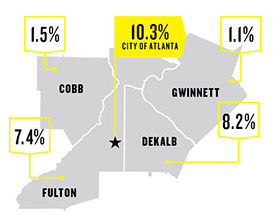In March, after five years with absolutely no public transit of any kind, the citizens of Clayton County will wake up to find MARTA buses rolling down their roads, the direct result of a 2014 election when Clayton voters overwhelmingly opted to levy a penny sales tax on themselves in exchange for joining the transit system. This is a historic chapter in MARTA’s history: the first major expansion in four decades. Much of the credit goes to the transit authority’s general manager and CEO Keith Parker, who joined MARTA in December 2012 when the agency was beleaguered with a fiscal crisis and plummeting ridership. Under Parker’s guidance, MARTA has increased revenue, stabilized ridership, lowered crime, and, most importantly, gotten the trains and buses running more frequently—and almost on time.

That was the easy part. Parker has a new and truly challenging goal: “We want to make it cool to ride MARTA,” he says. For that to happen, Parker and MARTA supporters need to re-engineer a mindset that’s prevailed for more than a half century. In many major cities—New York, Chicago, and Paris, for instance—transit is considered the smart, efficient way to get around town. Everyone rides the subways or buses because they’re faster and cheaper than any alternative. But in car-centric places like Atlanta, Houston, or Los Angeles, transit has been treated as the travel mode of last resort. Consider: 30 percent of people who live in the New York region commute by mass transit, compared with just 3 percent in metro Atlanta. Here, the thinking has been, you take MARTA if you can’t afford a car, if congestion is high (a Braves game!), or if you want to avoid hassles, like parking at the AJC Decatur Book Festival.
MARTA ridership declined from 156 million trips a year in 2009 to 134.8 million in 2012. There was little incentive to ride the system, with slashed bus routes, decreased train frequency, and a fare jacked up from $1.75 to $2.50 in just two years. Parker cut fat from the budget—bringing IT services in house, for instance, and switching to cost-efficient natural gas buses—and increased service. In November, he and the board settled negotiations with the labor union that employs most MARTA workers, resulting in the first pay increase since 2006 and resolving a lingering dispute that included workers slamming Parker’s salary ($320,000) and taking out an ad that featured his home (a white-columned McMansion).
Last year, ridership inched up, increasing by 1 million trips a month in July, August, and September 2014 compared with the same period in 2013. Usage boomed at the Buckhead station and along bus routes in the northern suburbs.
Commuters such as these—who ride transit because they want to, not just because they have to—will be essential to a meaningful shift in how MARTA is perceived and to its future growth. They’re called “choice riders,” and Parker has plans to appeal to them. Over the next year, the agency will roll out Wi-Fi service on buses and trains. As regular riders can attest, this will be huge; trying to catch up on email while riding MARTA can be maddening as service cuts off every time a train enters a tunnel. In addition, the agency plans a campaign touting the efficiency of its service to the airport.
The agency also is dealing with the less savory aspects of mass transit. A pilot project will test high-tech restrooms. Security cameras will be installed on all trains (they presently are in place in buses and stations). MARTA launched a campaign to thwart misbehaving passengers and developed the See & Say app, which allows customers to text its police officers when they spot rowdy riders. Another app, On the Go, tracks real-time bus and train arrivals and has been downloaded 15,000 times.
These efforts matter, but Parker’s also relying on market and demographic forces. State Farm is building its 2 million-square-foot headquarters adjacent to the Dunwoody station, while payment company WorldPay is relocating from Sandy Springs to Atlantic Station, with proximity to transit for its 1,200-plus staffers as a draw.
Developer Mark Toro, who regularly commutes by MARTA, says that he saw a “mind-shift” among his peers after the State Farm announcement. “The light went on,” Toro says. “Those kinds of decisions are now being made not to give executives offices near their country clubs, but where their employees live, and near transit. People need to have a way to get to work.”
Toro’s North American Properties manages Atlantic Station—intown, connected by shuttle to MARTA—and developed Avalon in Alpharetta. Toro was adamant that MARTA bus service extend to Avalon, and says that current and future development in North Fulton “to some extent will suffer unless transit options are afforded.”
Although there’s a lot of chatter about transit appealing to millennials, Toro says it’s equally important to focus on millennials’ parents. “The baby boom and the echo boom seem to be seeking the same thing at the same time,” he says.
Toro’s company is pursuing a development at the Brookhaven station (see below). “We have infinitely more confidence in current MARTA administration than we ever have,” he says of Parker. Development will happen “not because it’s the in thing to do or socially conscious, but because it makes sense as an investment.”
Station to Station
MARTA owns some prime real estate and has been at work trying to develop some of that property for a year. Under the scheme, MARTA will issue 99-year leases for underused parking lots around its stations or the “air rights” above them to developers, who in turn will put in mixed-use projects that house transit-happy residents and tax-base-bolstering shops and restaurants. The agency’s goal was to have five projects underway by mid-2015. Here’s where things stood at the start of the year.
 Avondale
Avondale
Area to be developed The south side of the station, where 7.7 acres of asphalt have been blocked off and unused.
Partners The city of Decatur’s development authority and Columbia Ventures, a firm specializing in urban residential projects.
The plan Create a central plaza surrounded by buildings that will contain 530 apartments—of which a significant number will be tailored for senior citizens—and 74 condos.
Construction start date Mid-2015
 King Memorial
King Memorial
Area to be developed A 4.3-acre parking lot on the station’s south side that is currently leased to Grady for hospital employee parking.
Partner Walton Communities, which has developed apartment complexes in Smyrna and Vinings.
The plan A dense mixed-use project with 386 apartments (one-fifth of which will be set aside for low-income residents) and a street-level retail area at the station, less than a mile from downtown.
Construction start date Early 2016
 Edgewood-Candler Park
Edgewood-Candler Park
Area to be developed Just over six acres of parking lots on the south side of the station—walking distance to the Edgewood Retail District.
Partners Columbia Ventures; Columbia Residential, which has a senior citizen complex near the Edgewood shops; and Invest Atlanta, the city’s development arm.
The plan Greenspace surrounded by 445 apartments—of which 89 will be set aside at affordable rents.
Construction start date Mid-2015
And in discussion
MARTA is developing guidelines—based on community meetings and feedback from developers—for the Oakland City, Brookhaven, and Arts Center stations. The latter could involve a high-rise hotel and apartments above the station. It will be the most complex of the developments, says Amanda Rhein, who joined MARTA in early 2014 from Invest Atlanta.
 Who Commutes By Transit?
Who Commutes By Transit?Metrowide, 3 percent of us use transit, less than many other big-city regions. Not surprisingly, use is highest in counties that offer bus and rail service, such as DeKalb and Fulton. In areas with only a bus system, like Cobb County, ridership is anemic. Shown right: percentages of residents who commute to work using transit, according to the Census Bureau’s 2013 American Community Survey.












![The North Carolina Museum of Natural Sciences’ newest exhibit is a [pre]historic first](https://cdn2.atlantamagazine.com/wp-content/uploads/sites/4/2024/04/DD-3-100x70.jpg)


